Derby's Heritage Part 01 - The Introduction
w/e 31 January 2010
All this week's pictures were taken
with a Kodak DX6490
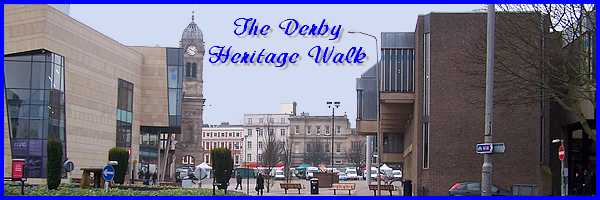
"Heritage" - So what do we understand by
the term "heritage"?Well when some building of interest
is demolished we've often heard said that we've lost part of
our heritage and I always associate the term with something from
many years ago. But in law, anything that "has been or may
be inherited by legal descent or succession" is regarded
as "heritage" so for the purpose of this series I suppose
that anything I come across from history or from modern times
can be regarded as fair game. That is the premise I am working
on anyway and as can be seen in the variety of architectural
styles from various times in history in the title image above,
the city of Derby has a great deal of heritage to be explored.
There are a variety of leaflets and guides usually available
from the Tourist Information Centre and I have managed to accumulate
quite a collection. One leaflet in particular includes three
walks - the Joseph Wright Walk, the City Circuit which includes
most of the Joseph Wright Walk and also takes in a whole lot
more of the city centre plus a Riverside Walk. A separate leaflet
looks at the wildlife along the River Derwent and yet another
details a heritage walk around Chester Green, just north of the
city centre. Finally another leaflet by the Derby Civic Society
includes details of over twenty "Heritage Buildings"
in central Derby with nearly thirty more in outer Derby. From
these and a number of other mini-guides I have devised a route
that will encompass many of the sites in or near the city centre.
It is perhaps worth pointing out now that there are already several
web sites that cover many of the places we will visit not least
among them, Andy Savage's Derby Photos, Mike Smith's Pictures
of Derby and Denis Eardley's Discover Derbyshire all of which
can be accessed from the Links page on this site but the difference
with this series is that we will be following a pre-determined
route and viewing the places in sequence. It will also be a voyage
of discovery for me as I learn more about our county capital.
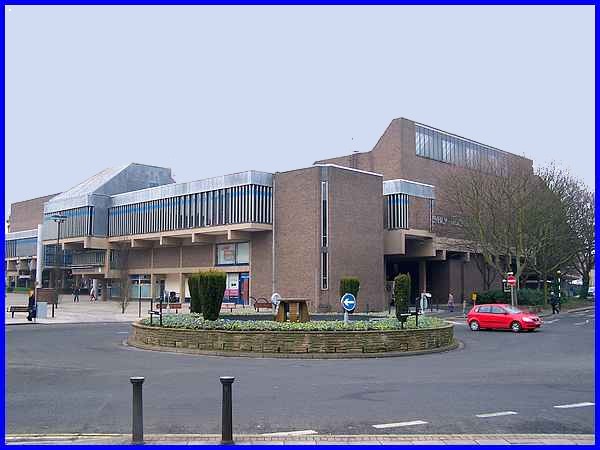
The route begins like many of those detailed in the aforementioned
leaflets at Derby’s largest arts and entertainment complex,
the Assembly Rooms. This series could be of epic proportions
as preliminary planning has already identified about a hundred
locations and the route will pass through the Market Place on
more than one occasion. In this initial part we will therefore,
only look at a few of the sites in the Market Place leaving some
for later parts in the series.
|
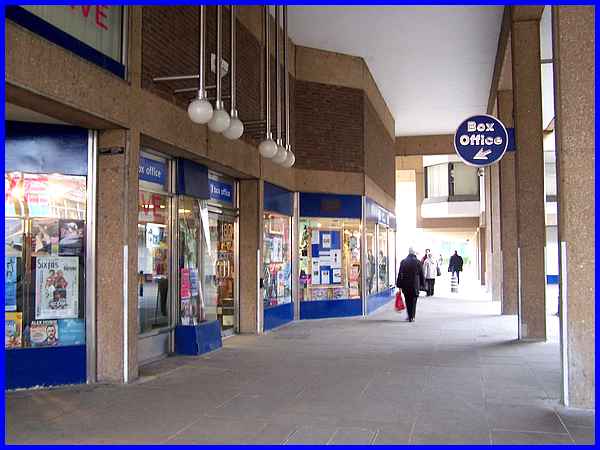
The modern Assembly Rooms, replacing an earlier building, opened
in 1977 and has two multipurpose auditoria, the Great Hall and
the Darwin Suite, the entrance to the Darwin Suite, a function
room with the flexibility to hold concerts and limited theatrical
presentations being on the extreme left of this image next to
the Box Office. Posters and flyers in the window advertise forthcoming
attractions and events.
|
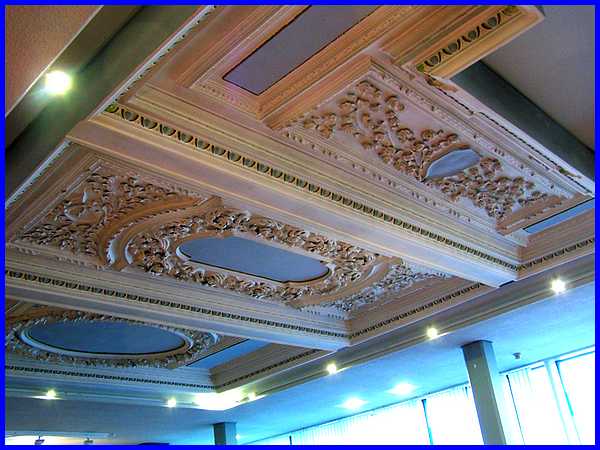
In the foyer of the Darwin Suite there is an almost complete
original Jacobean ceiling that came from the seventeenth century
Newcastle House that stood on the site of the development and
was discovered when it was demolished. A plaque on the wall in
the foyer (below) gives more details about the ceiling.
 Derby
is known as the "Ghost Capital of Great Britain" with
over 1,000 paranormal sightings, one of which is actually in
the Darwin Suite. It is reputedly haunted by a group of twentieth
century singing and dancing children and it has also been reported
that a Victorian woman has been seen walking in the building. Derby
is known as the "Ghost Capital of Great Britain" with
over 1,000 paranormal sightings, one of which is actually in
the Darwin Suite. It is reputedly haunted by a group of twentieth
century singing and dancing children and it has also been reported
that a Victorian woman has been seen walking in the building.
On our brief visit into the foyer to capture these images, I
have to say that no such apparitions made their presence known
to us - but we didn't hang about to find out.
The Darwin Suite itself is named in honour of Erasmus Darwin
(1731-1802) one of a number of famous Derbeians that we will
encounter in our walk around the city. Erasmus Darwin was born
at Elston Hall, near Newark on Trent in Nottinghamshire, educated
at Chesterfield in Derbyshire and at at St John's College, Cambridge.
He returned as a physician to Nottingham in 1756 and moved a
year later to Lichfield in Staffordshire. He wooed Elizabeth
Pole and she became his second wife following the death of her
husband. They moved to her home, Radbourne Hall, about four miles
west of Derby and then in 1782, to Full Street in Derby which
is adjacent to the Assembly Rooms. Darwin's final move to Breadsall
Priory on the outskirts of Derby was curtailed by his sudden
death in 1802 and he is buried in All Saints Church, Breadsall.
During his lifetime Erasmus Darwin had outlined an evolutionist
theory that paved the way for his more famous grandson's work
- Charles Darwin's "On The Origin Of Species". Charles
also had a famous grandfather on his maternal side from the Midlands
and that was Josiah Wedgwood of pottery fame.
|
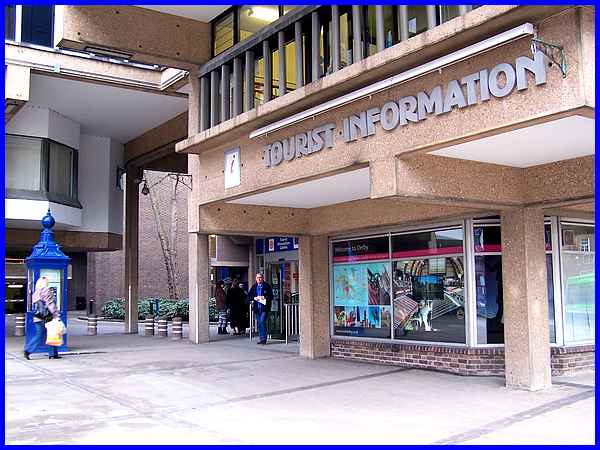
The Tourist Information Centre is part of the Assembly Rooms
Complex and stands where the original Assembly Rooms building
stood. That was built between 1752 and 1755 and was a place where
music recitals and dances were held for the middle classes.
|
|
It was still standing in the middle of the twentieth
century but was gutted by fire in November 1963 .
When demolished in the early 1970s the interior was lost forever
but the five bay stone facade was re-erected brick by brick at
the
National
Tramway Museum
in Crich just a few miles north of Derby where it can still
be seen.
|
|
There is also a photo of the building in its original position
on the bygonederbyshire website here.
|
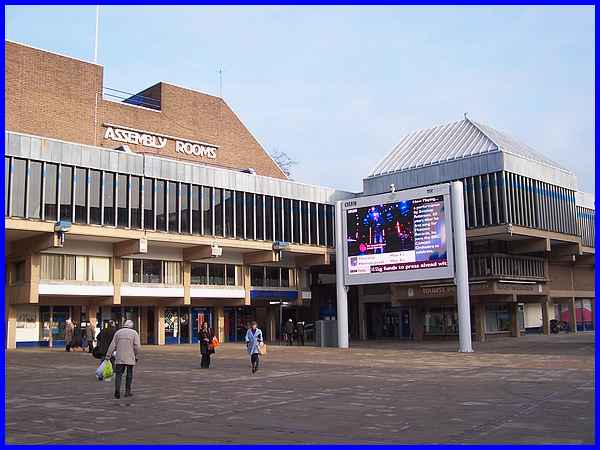
The view today is unrecognisable from the image at bygonederbyshire
but the Tourist Information Centre where the original building
stood is directly behind the Big Screen that was erected and
launched in July 2007. The screen itself is one of twenty or
more in various cities throughout the country that is a collaboration
between the BBC, the London Organising Committee of the Olympic
Games and local authorities.
Quoting from the BBC site: "With a 360 degree camera on
top and ability to interact with events below, Derby's Big Screen
is much more than just a big telly." At the opening of the
Big Screen, people in the Market Place were able to watch live
opera from Covent Garden and many other events have been screened
since including live events and community projects from across
the region.
|
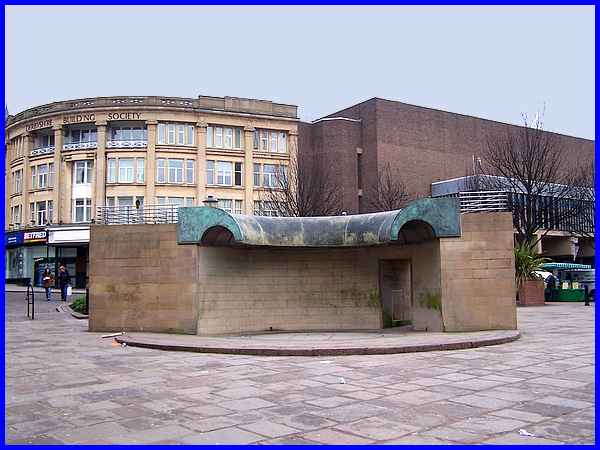
At the opposite end of the Market Place to the Tourist Information
Centre and the Big Screen is the Waterfall Feature - or as can
be seen in this image the waterless feature - designed by William
Pye. It was built in 1995 but I've not seen water flowing over
the structure for some time now. I don't know whether it has
just been switched off during the winter months as a safety precaution
but as we will be passing this way again later I'll try and capture
an image when it is in full flow.
|
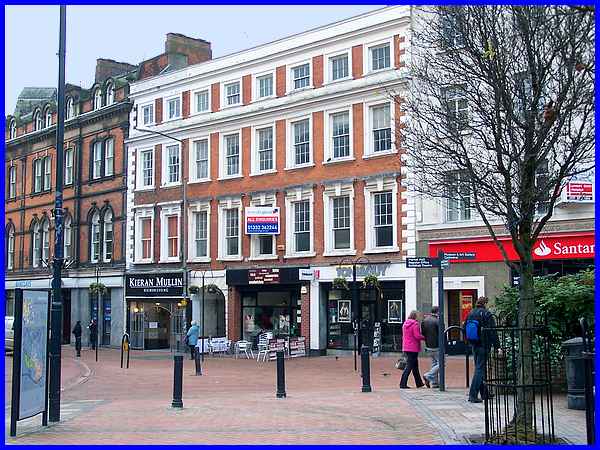
Also at the far end of the Market Place is the building known
as Franceys's House. It dates from 1695 and was built for Alderman
William Franceys. The building that replaced a house built in
1640 by his uncle once had two first floor rooms with frescoed
ceilings by Francis Bassano. The Franceys were originally butchers
moving to the area in 1582. Both William and his son Henry traded
as chemists or apothecaries as they were then known and both
became Mayors of Derby, William in 1697 and 1699 and Henry in
1747. Henry however died while in office and his term was completed
by the previous Mayor, Humphrey Booth. Their store on the ground
floor of the building survived until 1971.
|
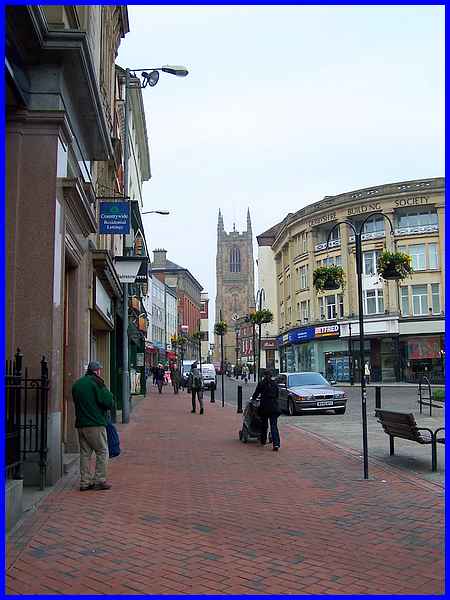
Our route from outside Franceys's House will take us along Irongate
towards Derby Cathedral and in the next part we will meet another
famous Derbeian, the celebrated artist Joseph Wright. Derby achieved
city status on June 7th 1977 to mark the 25th anniversary of
Queen Elizabeth II's ascension to the throne. During her reign,
the Queen has visited Derby several times and it was announced
this week that her next visit is scheduled for April 1st when
she will be distributing Maundy Money at the Cathedral on Maundy
Thursday.
|

